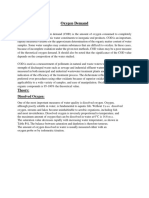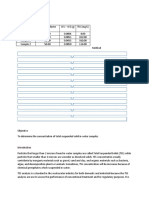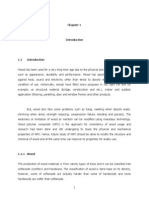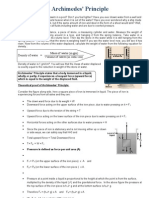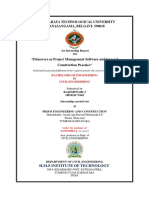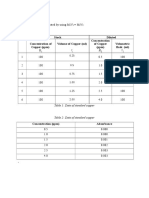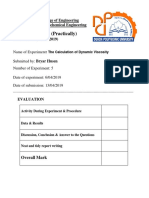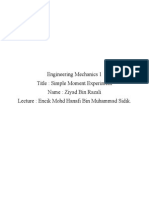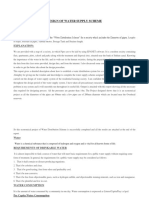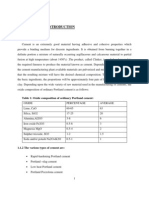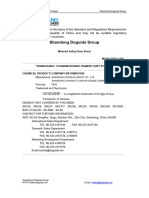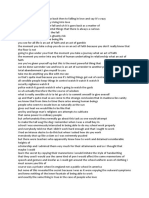Chapter - 1: Experimental Analysis of Concrete Incorporating Waste Foundry Sand and Waste Ceramic Tiles
Chapter - 1: Experimental Analysis of Concrete Incorporating Waste Foundry Sand and Waste Ceramic Tiles
Uploaded by
Irfan KhanOriginal Description:
Original Title
Copyright
Available Formats
Share this document
Did you find this document useful?
Is this content inappropriate?
Report this DocumentCopyright:
Available Formats
Chapter - 1: Experimental Analysis of Concrete Incorporating Waste Foundry Sand and Waste Ceramic Tiles
Chapter - 1: Experimental Analysis of Concrete Incorporating Waste Foundry Sand and Waste Ceramic Tiles
Uploaded by
Irfan KhanCopyright:
Available Formats
Experimental Analysis of Concrete Incorporating Waste Foundry Sand and
Waste Ceramic Tiles
CHAPTER – 1
INTRODUCTION
Foundry sand is a sand that when moistened and compressed or oiled or heated tends
to pack well and hold its shape. It is also known as moulding sand. It is used in the process of
sand casting for preparing the mould cavity. The foundry sand is high quality sand with
uniform physical characteristics. It is a by product of ferrous and non-ferrous metal casting
industries where sand has been used for centuries as a molding material because of its
thermal conductivity and its unique engineering properties. In modern foundry practice, sand
is typically recycled and reused through many production cycles. Industry estimates are that
approximately 100 million tons of sand is used in production annually. The main ingredients
for manufacturing of concrete are cement, course aggregates, fine aggregates, waste ceramic
tiles and waste foundry sand. Foundries successfully recycle and reuse the sand many times
in a foundry. When the sand can no longer be reused in the foundry, it is removed from the
foundry and is termed as waste foundry sand.
The sand is used in two different ways in metal casting: as a molding material, which
forms the external shape of the cast part, and as cores, which form internal void spaces in
products such as engine blocks. Since sand grains do not naturally adhere to each other, the
binders must be introduced to cause the sand to stick together and hold its shape during the
introduction of the molten metal into the mold and the cooling of the casting. Two general
types of binder systems are used in metal casting depending upon which the foundry sands
are classified as: clay bonded systems (Green sand) and chemically- bonded systems. Both
types of sands are suitable for beneficial use but they have different physical and
environmental characteristics.
Department of Civil Engineering Page 1
K.B.N. College of Engineering, Kalaburagi
Experimental Analysis of Concrete Incorporating Waste Foundry Sand and
Waste Ceramic Tiles
1.1 Materials:
The materials used during the study include:
Cement
Fine aggregate
coarse aggregate
Water
Waste Foundry Sand
Waste Ceremic Tiles
1.1.1 Cement:
Portland cementis the most common type of cement in general use around the world, used
as a basic ingredient of concrete, mortar, stucco, and most non-speciality grout. It was
developed from other types of hydraulic lime in England in the mid-19th century and usually
originates from limestone. It is a fine powder produced by heating materials in a kiln to form
what is called clinker, grinding the clinker, and adding small amounts of other materials.
Several types of Portland cement are available with the most common being called ordinary
Portland cement (OPC) which is grey in colour, but a white Portland cement is also available
Portland cement is caustic, so it can cause chemical burns, the powder can cause irritation
or with severe exposure lung cancer, and can contain some hazardous components such as
crystalline silica and hexavalent chromium. Environmental concerns are the high energy
consumption required to mine, manufacture, and transport the cement and the related air
pollution including the release of greenhouse gases (e.g., carbon dioxide), dioxin, NOx, SO2,
and particulates.
The low cost and widespread availability of the limestone, shale, and other naturally
occurring materials used in Portland cement make it one of the lowest-cost materials widely
used over the last century throughout the world. Concrete produced from Portland cement is
one of the most versatile construction materials available in the world.
Department of Civil Engineering Page 2
K.B.N. College of Engineering, Kalaburagi
Experimental Analysis of Concrete Incorporating Waste Foundry Sand and
Waste Ceramic Tiles
Fig 1.1 Cement bag of 50 kg
1.1.2 Fine Aggregate:
Aggregates are defined as inert, granular, and inorganic materials that normally
consist of stone or stone-like solids. Aggregates can be used alone (in road bases and various
types of fill) or can be used with cementing materials (such as Portland cement or asphalt
cement) to form composite materials or concrete. The most popular use of aggregates is to
form Portland cement concrete. Approximately three-fourths of the volume of Portland
cement concrete is occupied by aggregate. It is inevitable that a constituent occupying such a
large percentage of the mass should have an important effect on the properties of both the
fresh and hardened products. As another important application, aggregates are used in asphalt
cement concrete in which they occupy 90% or more of the total volume. Once again,
aggregates can largely influence the composite properties due to its large volume fraction.
Fine agrregate 4.75mm down locally available at Kalaburagi Karnataka.
Classification of aggregate: Aggregates can be divided into several categories according to
different criteria.
Fine aggregate (sand): Aggregates passing (4.75 mm) sieve and predominately retained on
the (75 mm) sieve.
Department of Civil Engineering Page 3
K.B.N. College of Engineering, Kalaburagi
Experimental Analysis of Concrete Incorporating Waste Foundry Sand and
Waste Ceramic Tiles
1.1.3 Coarse Aggregate:
Coarse aggregate: Aggregates predominately retained on the (4.75 mm) sieve. For
mass concrete, the maximum size can be as large as 150 mm. coarse aggregate 20mm down
sized available locally at Kalaburagi Karnataka.
In accordance with sources:
Natural aggregates: This kind of aggregate is taken from natural deposits without changing
their nature during the process of production such as crushing and grinding. Some examples
in this category are sand, crushed limestone, and gravel
Manufactured (synthetic) aggregates: This is a kind of man-made materials produced as a
main product or an industrial by-product. Some examples are blast furnace slag, light weight
aggregate (e.g. expanded perlite), and heavy weight aggregates (e.g. iron ore or crushed
steel).
Fig 1.2. Coarse aggregate 20mm down
1.1.4 Water:
Portable water from the Department of Civil Engineering, Appa Institute of Engineering
& Technology and was used both for the mixing of concrete as well as in curing of the cubes.
The M-sand was sun dried for 24 hours to remove moisture from it. The burnt sand was
collected and sieved through a IS sieve (75 microns). The resulting sand, which has the
required fineness, was collected for use. Using a mix design ratio of 1:1:3 and water binder
ratio of 0.45, a total of 45 concrete cubes of size 150mmx150mmx150mm were cast using
varying OPC-CSA ratio of 100:0, 75:25, 50:50, 25:75, 100:100, respectively, i.e., 9 cubes per
% replacement. The cubes were cured and crushed after 3, 7, 28 days respectively and
strength results are presented.
Department of Civil Engineering Page 4
K.B.N. College of Engineering, Kalaburagi
Experimental Analysis of Concrete Incorporating Waste Foundry Sand and
Waste Ceramic Tiles
1.1.5 Waste Foundry Sand (WFS):
Foundry sand is high quality silica sand with uniform physical characteristics. It is
produced from ferrous and nonferrous metal casting industries, where sand has been used for
centuries as a molding material because of its thermal conductivity. Indian foundries produce
approximately 1.71 million tons of waste foundry sand each year (Metal World, 2006). In the
casting process, heat and mechanical abrasion eventually render the sand and thus unsuitable
for use in casting molds, and a portion of the sand is continuously removed and replaced with
new one. This sand is treated as waste from casting industry and because of high silica
content it cannot be disposed easily. Waste foundry sand is made up of mostly natural sand
material. Its properties are similar to the properties of natural or manufactured sand, the
fineness modulus of waste foundry sand is 3.027. Thus it can normally be used as a
replacement of sand.
The considerable disposal expense has made the current practice of WFS disposal in
landfills less favorable. Besides the financial burden to the foundries, land-filling WFS also
make them liable for future environmental costs, remediation problems and regulation
restrictions. This issue is increasingly addressed by alternate options of reusing WFS
beneficially. Beneficial reuses of WFS in variety of applications related to infrastructure
engineering and rehabilitation works. Some of the researchers have reported the possible use
of waste foundry sand in different civil engineering applications. These alternate applications
offer cost savings for both foundries and user industries and environmental benefits at the
local and national level.
Department of Civil Engineering Page 5
K.B.N. College of Engineering, Kalaburagi
Experimental Analysis of Concrete Incorporating Waste Foundry Sand and
Waste Ceramic Tiles
Chemical Properties of Foundry Sand”
Sl.No. Constituent Value (%)
1 SiO2 83.93
2. Al2O3 0.021
3. Fe2O3 0.950
4. CaO 1.03
5. MgO 1.77
6. SO3 0.057
7. LOI 2.19
1.1.6. Waste Ceramic Tiles (WCT):
India ranks in the top 3 list of countries in terms of tiles production in the world. This
huge amount of ceramic tiles are not recycled but is often used as pavement material or
landfill. Ceramic tile aggregates are hard having considerable value of specific gravity, rough
surface on one side and smooth on other side, having less thickness and are lighter in weight
than normal stone aggregates. Using ceramic tile aggregate in concrete not only it will be cost
effective, but also provide considerable strength to the concrete. Construction industries
requires huge amount of ceramic tiles and other ceramic for architectural appearance, the
productions of which are drastically increased, due to this waste is also produce during
handling and usage of ceramic tiles. As 30 to 40% of the total production from manufacturing
units is solid waste. So, we selected these waste tiles as a replacement material to the basic
natural aggregate. Tiles are a mixture of clays that are pressed into shape and fired at high
temperatures which gives the hardness. Ceramic products are made from natural materials
which contain a high proportion of clay minerals.
These, through a process of dehydration followed by controlled firing at temperatures
of between 700ºC and 1000ºC, acquire the characteristic properties of “fired clay”. Ceramic
waste may come from two sources. The first source is the ceramics industry, and this waste is
classified as non-hazardous industrial waste (NHIW). The second source of ceramic waste is
associated with construction and demolition activity, and constitutes a significant fraction of
construction and demolition waste (CDW). Reuse of this kind of waste has many advantages,
Department of Civil Engineering Page 6
K.B.N. College of Engineering, Kalaburagi
Experimental Analysis of Concrete Incorporating Waste Foundry Sand and
Waste Ceramic Tiles
not least of which are the economic advantages, including job creation in companies
specializing in the selection and recycling of this kind of material. It goes without saying that
reuse is better than recycling.
“Figure1. Waste Ceramic Tiles” “Figure2. Waste Foundry Sand”
Department of Civil Engineering Page 7
K.B.N. College of Engineering, Kalaburagi
Experimental Analysis of Concrete Incorporating Waste Foundry Sand and
Waste Ceramic Tiles
CHAPTER-2
OBJECTIVE
To investigate by improvement in compressive strength, flexural strength and tensile
strength
To check the workability of the concrete by replacing natural sand by Waste Foundry
Sand & Waste Ceramic Tiles.
To identify the use of this waste materials in regular construction.
Department of Civil Engineering Page 8
K.B.N. College of Engineering, Kalaburagi
Experimental Analysis of Concrete Incorporating Waste Foundry Sand and
Waste Ceramic Tiles
CHAPTER – 3
LITERATURE REVIEW
Many authors have submitted the report for the use of foundry sand and waste
ceramic tiles in different civil engineering applications and different engineering structures
like dams, bridges, high rise buildings and other type of structures. Tarun R. Naik, Viral M.
Patel, 1994 conducted a project to evaluate performance and leaching of CLSM in which
both clean and used foundry sands were incorporated. The clean sand was obtained from a
sand mining company in Wisconsin and the used foundry sand was obtained from a steel
company in Milwaukee, Wisconsin. For purposes of comparison, properties of regular
concrete sand (meeting ASTM C 33 requirements for use in making concrete) were also
measured. Physical properties of these three foundry sands were determined using the
appropriate ASTM standard .However a modified ASTM C 88 was used to measure
soundness of foundry sands.
The properties of used foundry sand vary due to the type of foundry processing
equipments used, the type of additive for mold making, the number of times the sand is
reused, and the type and amount of binder used. Hanyoung also investigated two types of
foundry sands like silicate bonded sand as a fine aggregate and clay bonded sand also as a
fine aggregate for the concrete and also performed the test for the basic and important
properties of concrete like slump test, workability test, initial setting time of concrete, final
setting time of concrete with the use of waste foundry sand and then, compared the results of
tests with another concrete without mixed with waste foundry sand. Also measured the
compressive strength, tensile strength and split tensile strength of that concrete for 7 days and
28 days.
Department of Civil Engineering Page 9
K.B.N. College of Engineering, Kalaburagi
Experimental Analysis of Concrete Incorporating Waste Foundry Sand and
Waste Ceramic Tiles
CHAPTER – 4
EXPERIMENTAL INVESTIGATION
The materials used for concrete for this study were Portland cement, waste foundry
sand natural sand, aggregate and waste ceramic tiles, manufactured by Ultra Tech Cement
from Mulched was used. Aggregate of nominal size 20mm was used as coarse aggregate. The
sand used was source from sand suppliers. The average bulk density was 1550 kgm-3, with a
fineness modulus of 2.5. It was flushed with water to remove fines and dirt and sun dried
before use. The waste foundry sand obtain from stone crusher, Kalaburagi. Ordinary potable
tap water produced at campus was used in mixing the materials. It appeared clean and free
from any visible impurities conforming to the requirements of
A concrete mix of ratio of 1:1:2 by volume, with a water cement ratio of 0.46 was
used as control, which the properties of all other mixes were compared. Waste Foundry sand
& waste Ceramic tiles were used to replace 0%, 10%, 20%, 30, and 40% of the natural sand
and coarse aggregate by volume. Different mixes were batched and 15, specimens of each
mix were produced. Concrete was cast in pre-oiled cast iron moulds.
Fig. 4.1: Cast iron moulds
After casting, the moulds were covered with plastic sheets to prevent water loss
through evaporation. After 24 hours, the cubes were demoulded and immersed in a curing
tank to cure for strength gain. The curing process is beneficial to hydration of cement, while
improving the physical and mechanical properties of concrete. On each day of testing, the
specimens were removed from the tank and placed in the open air for about two hours.The
compressive strength of the concrete specimen was determined by crushing after
determination of density. The results for the density and compressive strengths are the
average of three tests.
Department of Civil Engineering Page 10
K.B.N. College of Engineering, Kalaburagi
Experimental Analysis of Concrete Incorporating Waste Foundry Sand and
Waste Ceramic Tiles
CHAPTER – 5
PRIMARY INVESTIGATION TEST ON MATERIAL
5.1 Specific gravity of cement
5.2 Specific gravity for fine aggregate
5.3 Specific gravity for coarse aggregate
5.4 Specific gravity of waste foundary sand
5.5 Slump test
5.6 Compressive strength test
5.7 Split tensile
5.8 Flexural strength test
5.1 Specific gravity of cement
TABLE NO 5.1
SI NO PROPERTIES VALUE
01 Specific gravity 3.11
02 Standard consistency 33%
03 Initial setting time in min 30
04 Final setting time in min 480
5.2 Specific gravity for fine aggregate
TABLE 5.2
SI NO PROPERTIES VALUE
01 Specific gravity 2.61
02 Fineness modulus 2.853
03 Water absorption 1.23 %
04 Zone I
Department of Civil Engineering Page 11
K.B.N. College of Engineering, Kalaburagi
Experimental Analysis of Concrete Incorporating Waste Foundry Sand and
Waste Ceramic Tiles
5.3 Specific gravity for coarse aggregate
TABLE 5.3
SI NO POPERTIES VALUES
01 Specific gravity 2.85
02 Fineness modulus 2.56
03 Water absorption 1.23
5.4 Specific gravity of waste foundry sand:
TABLE 5.4
SI NO POPERTIES VALUES
01 Specific gravity 2.59
02 Fineness modulus 2.6
03 Water absorption 1.1
Sieve Analysis:
The name given to the operation of dividing a sample of aggregate into various
fraction each consisting of particles of the same size. The sieve analysis is conducted to
determine the particle size distribution in a sample of aggregate, which we call gradation.
Fig. 5.1: IS Sieves
The aggregate used for making concrete are normally of the maximum size
80mm,40mm, 20mm, 10mm, 4.75mm, 2.36mm, 600micron, 300micron, 150micron and
Department of Civil Engineering Page 12
K.B.N. College of Engineering, Kalaburagi
Experimental Analysis of Concrete Incorporating Waste Foundry Sand and
Waste Ceramic Tiles
75micronS Sieves. In the IS and AST standards, the sieve sizes are given in times of the
number of openings per inch is equal to the square of the number of sieves. In the IS460-
1962, the sieves are designed by size of the aperture in mm.
5.5 Slump Cone Test:
The apparatus used for conducting the slump test consists of slump cone.
The internal surface of the mould is thoroughly cleaned and free from
moisture and adherence of any old set concrete before commencing the test.
Concrete is placed in the mould and is removed for slump value.
The test is carried out using a mould known as a slump cone or Abram’s cone. The
coneis placed on a hard non-absorbent surface. This cone is filled with fresh concrete in three
stages. Each time, each layer is tamped 25 times with a rod of standard dimensions. At the
end of thethird stage, concrete is struck off flush to the top of the mould. The mould is
carefully liftedvertically upwards with twisting motion, so as not to disturb the concrete cone.
Concrete subsides. This subsidence is termed as slump, and is measured to the nearest 5 mm
if the slump is <100 mm and measured to the nearest 10 mm if the slump is >100 mm.
Fig. 5.2: Types of slump
Department of Civil Engineering Page 13
K.B.N. College of Engineering, Kalaburagi
Experimental Analysis of Concrete Incorporating Waste Foundry Sand and
Waste Ceramic Tiles
Table 5.5 Workability of concrete at conventional and replace stages
% W/C Degree of
Sl.No. Water Added Slump
Replacement ratio Workability
1 0 200 0.46 7 Low
2 10 200 0.46 42 Low
3 20 200 0.46 76 Medium
4 30 200 0.46 105 High
5. 40 200 0.46 137 High
Percentage of Waste foundry sand v/s slump value
Department of Civil Engineering Page 14
K.B.N. College of Engineering, Kalaburagi
Experimental Analysis of Concrete Incorporating Waste Foundry Sand and
Waste Ceramic Tiles
5.6 Compressive Strength Test:
To calculate the compressive strength of concrete cubes the universal testing machine
(UTM) having capacity of 2000 kN tonne was used. Compressive strength test, mechanical
test measuring the maximum amount of compressive load a material can bear before
fracturing. The test piece, usually in the form of a cube, prism, or cylinder, is compressed
between the platens of a compression-testing machine by a gradually applied load.
Brittle materials such as rock, brick, cast iron, and concrete may exhibit great
compressive strengths; but ultimately they fracture. The crushing strength of concrete,
determined by breaking a cube, and often called the cube strength, reaches values of about 3
tons per square inch, that of granite 10 tonnes per square inch, and that of cast iron from 25 to
60 tons per square inch.
Some ductile metals, such as mild steel, have very great compressive strengths; but
the actual values are difficult to measure. When a load is applied to a ductile metal, it deforms
elastically up to a certain point, and then plastic deformation occurs. Increasing loads may
even completely flatten a test piece without any definite fracture occurring, so that no value
can be obtained for the compressive strength. The custom of quoting tensile-strength values
in these cases is inaccurate but safe, compressive strength being always greater.
Fig. 5.3: Compression testing machine
Department of Civil Engineering Page 15
K.B.N. College of Engineering, Kalaburagi
Experimental Analysis of Concrete Incorporating Waste Foundry Sand and
Waste Ceramic Tiles
It is the standard test, to determine the compressive strength of concrete in an indirect way
.This test could be performed in accordance with IS: 5816-1970.
A standard test cube of concrete specimen (150 mm X 150mm X 150mm) is placed
horizontally between the loading surfaces of Compression Testing Machine (Fig-4.1)
Now we got the ultimate load. So we can now calculate the concrete compressive strength.
Compressive strength =
= (N/mm2)
5.7 Split Tensile Test
It is the standard test, to determine the tensile strength of concrete in an indirect
way .This test could be performed in accordance with IS: 5816-1970.
A standard test cylinder of concrete specimen (300 mm X 150mm diameter) is placed
horizontally between the loading surfaces of Compression Testing Machine (Fig-4.1). The
compression load is applied diametrically and uniformly along the length of cylinder until the
failure of the cylinder along the vertical diameter. To allow the uniform distribution of this
applied load and to reduce the magnitude of the high compressive stresses near the points of
application of this load, strips of plywood are placed between the specimen and loading
platens of the testing machine. Concrete cylinders split into two halves along this vertical
plane due to indirect tensile stress generated by Poisson’s effect.
Department of Civil Engineering Page 16
K.B.N. College of Engineering, Kalaburagi
Experimental Analysis of Concrete Incorporating Waste Foundry Sand and
Waste Ceramic Tiles
Fig. 5.4: Split Tensile testing machine
Due to this compressive loading, an element lying along the vertical diameter of the cylinder
is subjected to a vertical compressive stress and a horizontal stress (Fig-4). The loading
condition produces a high compressive stress immediately below the loading points. But the
larger portion of cylinder, corresponding to its depth is subjected to uniform tensile stress
acting horizontally. It is estimated that the compressive stress is acting for about 1/6 depth
and the remaining 5/6 depth is subjected to tension due to Poisson’s effect.
Assuming concrete specimen behaves as an elastic body, a uniform lateral tensile stress of
ftacting along the vertical plane causes the failure of the specimen, which can be calculated
from the formula as,
Split tensile strength =
Where
P = Compressive load at failure
L = Length of cylinder
D = Diameter of cylinder
The above test result represents the "Splitting Tensile Strength" of concrete that varies
between 1/8 to 1/12 of the cube compressive strength.
5.8 Flexural Strength Test:
The test could be performed in accordance with as per BS 1881: Part 118: 1983. A
simple plain concrete beam is loaded at one-third span points. Normal standard size of
specimen is 100x100x500 mm. If the largest nominal size of the aggregate does not exceed
25mm, size of 100x100x500 mm may also be used. Span of the beam is three times its depth.
Equal Loads are applied at the distance of one-third from both of the beam supports. It
induces equal reaction same as the loading at both of the supports. Loading on beam is
increased in such a manner that rate of increase in stress in the bottom fibre lies within the
Department of Civil Engineering Page 17
K.B.N. College of Engineering, Kalaburagi
Experimental Analysis of Concrete Incorporating Waste Foundry Sand and
Waste Ceramic Tiles
range of 0.02 MPa& 0.10 MPa. The lower rate being for low strength concrete and the higher
rate for high strength concrete.
From the above loading configuration it is clear that at the middle one-third portion,
in between two loadings, beam is subjected to pure bending. No shear force is induced within
this portion. It is this portion of beam where maximum pure bending moment of Pd/2 is
induced accompanied by zero shear force.
As loading increases, if fracture occurs within the middle one-third of the beam, the
maximum tensile stress reached called "modulus of rupture" fbtis computed from the
standard flexure formula.
Flexural strength = 2 = (N/mm2)
Where
P = Compressive load at failure
L = Beam span between supports
d = Depth of beam
b = Width of beam
Fig. 5.5: Flexural testing machine
Department of Civil Engineering Page 18
K.B.N. College of Engineering, Kalaburagi
Experimental Analysis of Concrete Incorporating Waste Foundry Sand and
Waste Ceramic Tiles
CHAPTER-6
METHDOLOGY ADOPTED FOR CONCRETE MIX
Mix design is a process of selecting suitable ingredients for concrete and determining
their proportions which would produce, as economically as possible, a concrete that satisfies
the job requirements. In pursuit of the goal of obtaining concrete with desired performance
characteristics, the selection of component materials is the first step, the next step is a process
called mix design by which one arrives at the right combination of the ingredients. The mix
proportion was modified by replacing fine aggregate by waste foundry sand (WFS) and
coarse aggregate by waste ceramic tiles (WCT) in the range of 0%, 10%, 20%, 30% and 40%
both. Mix design was carried out manually conforming to IS10262:2009.
6.1 Mix design for M30 grade Concrete
a) Grade of designation = M25
b) Type of cement = OPC 43 grade
c) Maximum nominal size of aggregate = 20 mm
d) Minimum cement content = 320 kg/m3
e) Maximum w/c ratio = 0.50
f) Workability =75 mm slump
g) Exposure condition = Moderate (R.C.C)
h) Method of concrete placing = manually
i) Degree of supervision = good
j) Type of aggregate = crushed angular agg
k) Maximum cement content = 450 kg/m3
TEST DATA FOR MATERIALS
a) Cement used = Opc 43 grade
b) Specific gravity of cement = 3.11
c) Specific gravity of
1) Coarse aggregate = 2.85
2) Fine aggregate = 2.61
3) Manufacturing sand= 2.54
d) Water absorption
1) Coarse aggregate = 0.9 %
2) Fine aggregate = 1.23 %
3) Manufacturing sand= 1.1 %
e) Free moisture
1) Coarse aggregate = NIL
2) Fine aggregate = NIL
Department of Civil Engineering Page 19
K.B.N. College of Engineering, Kalaburagi
Experimental Analysis of Concrete Incorporating Waste Foundry Sand and
Waste Ceramic Tiles
3) Manufacturing sand= NIL
f) Fine aggregate= conforming to grading zone 1
Step 1 : Target strength for mix proportioning
Fck = fck + 1.65 x S
= 30 + 1.65 x 4
= 38.26 N/mm2
Step 2 : Selection of water cement ratio
Adopting 0.45 w/c ratio
Step 3 : Selection of water content
From table 2, minimum water content = 186 litres (25 to 50mm slump) Estimated water
content for 100mm slump
= 186+
= 197 Ltrs
Step 4 : Calculation of cement content
Water cement ratio = 0.45
Cement content = = 437.78 kg/
437.78 kg/ >320 kg/
[HENCEOK]
Step 5 : Proportion of volume of Fine aggregate and Coarse aggregate
Department of Civil Engineering Page 20
K.B.N. College of Engineering, Kalaburagi
Experimental Analysis of Concrete Incorporating Waste Foundry Sand and
Waste Ceramic Tiles
From table 3 volume of C.A. corresponding to 20mm size aggregate and F.A zone-I for W/C
ratio of 0.45 = 0.6
For mannully concrete these values should be reduced by 10%
Therefore volume of C.A = .6 x 0.9 = 0.54
Volume of the F.A = 1 - 0.54 = 0.46
Step 6 : Mix calculations
The mix calculations per unit volume of concrete shall be as follows
a) Volume of concrete = M30
b) Volume of cement =
= 0.141
c) Volume of water =
= 0.197
d) Volume of all in aggregate = [a-(b+c)]
= [1-(0.141 + 0.197)]
= 0.662
Department of Civil Engineering Page 21
K.B.N. College of Engineering, Kalaburagi
Experimental Analysis of Concrete Incorporating Waste Foundry Sand and
Waste Ceramic Tiles
e) Mass of Coarse aggregate = [d x volume of CA x S.P of CA] x 1000
= [0.662 x 0.54 x 2.85] x 1000
= 1132.02
f) Mass of fine aggregate = [d x F.A x S.P of F.A] x 1000
=[ 0.662 x 0.46 x 2.6] x 1000
= 691.12 kg
Department of Civil Engineering Page 22
K.B.N. College of Engineering, Kalaburagi
Experimental Analysis of Concrete Incorporating Waste Foundry Sand and
Waste Ceramic Tiles
Step 7 : Mix proportions
Cement = 437.78 kg/
Water = 197 kg/
Fine aggregate = 691.12 kg/
Coarse aggregate = 1132 kg/
Water cement ratio = 0.45
Ratio = 1:1.58:2.58
Table. Conventional Concrete Mix Proportion (M25)
Fine Aggregate Coarse Aggregate
Water (Lit) Cement (Kg/m3)
(Kg/m3) (Kg/m3)
203 435.5 653.38 1173.7
0.46 1 1.5 2.696
Modified Mix Proportion for Replacement of Fine Aggregate by WFS and Coarse
Aggregate by WCT”
Concrete mix design proportion
Sl.No. % Replacement w/c
C FA CA WFS WCT
ratio
1 0% 0.46 1 1.5 2.696 0 0
2 10% 0.46 1 1.35 2.43 0.15 0.27
3 20% 0.46 1 1.2 2.16 0.3 0.54
4 30% 0.46 1 1.05 1.89 0.45 0.81
5 40% 0.46 1 0.9 1.62 0.60 1.08
C=Cement, FA=Fine Aggregate, CA=Coarse Aggregate, WFS=Waste Foundry Sand,
WCT=Waste, Ceramic Tiles
Department of Civil Engineering Page 23
K.B.N. College of Engineering, Kalaburagi
Experimental Analysis of Concrete Incorporating Waste Foundry Sand and
Waste Ceramic Tiles
Coding % replacement
Concrete mix design
Department of Civil Engineering Page 24
K.B.N. College of Engineering, Kalaburagi
Experimental Analysis of Concrete Incorporating Waste Foundry Sand and
Waste Ceramic Tiles
CHAPTER – 7
RESULT AND DISCUSSION
Table 7.1: Compressive strength test
% age of Curing Surface Load Compressive
replacement age Area (mm2) (Kn) strength
(days) (N/mm2)
7 22500 422 18. 5
7 22500 425 18. 8
7 22500 428 19.02
0 28 22500 708 31.5
28 22500 702 31.2
28 22500 715 31.8
7 22500 435 19.33
7 22500 440 19.56
7 22500 437 19.42
10
28 22500 738 32.8
28 22500 744 33.1
28 22500 748 33.28
7 22500 452 20.10
7 22500 456 20.24
7 22500 459 20.4
20
28 22500 817 36.3
28 22500 807 35.9
28 22500 812 36.1
7 22500 408 18.15
7 22500 410 18.20
7 22500 413 18.32
30
28 22500 722 32.10
28 22500 715 31.8
28 22500 727 32.35
Department of Civil Engineering Page 25
K.B.N. College of Engineering, Kalaburagi
Experimental Analysis of Concrete Incorporating Waste Foundry Sand and
Waste Ceramic Tiles
7 22500 364 16.15
7 22500 367 16.28
7 22500 368 16.35
40
28 22500 650 28.9
28 22500 656 29.15
28 22500 660 29.35
Department of Civil Engineering Page 26
K.B.N. College of Engineering, Kalaburagi
Experimental Analysis of Concrete Incorporating Waste Foundry Sand and
Waste Ceramic Tiles
Table 7.2: Average Compressive strength
% age of Curing age Average strength
Replacement days (N/ )
7 18.77
0%
28 31.5
7 19.43
10% 28 33.06
7 20.24
20%
28 36.1
7 18.22
30% 28 32.08
7 16.26
40% 28 29.13
Department of Civil Engineering Page 27
K.B.N. College of Engineering, Kalaburagi
Experimental Analysis of Concrete Incorporating Waste Foundry Sand and
Waste Ceramic Tiles
Compressive strength v/s percentage of waste foundry sand replacement for 7 days
Compressive strength v/s percentage of waste foundry sand replacement for 28 days
Department of Civil Engineering Page 28
K.B.N. College of Engineering, Kalaburagi
Experimental Analysis of Concrete Incorporating Waste Foundry Sand and
Waste Ceramic Tiles
Compressive Testing Cubes:
Fig. Test Setup for Cube
Fig. Failure pattern of Cube
Department of Civil Engineering Page 29
K.B.N. College of Engineering, Kalaburagi
Experimental Analysis of Concrete Incorporating Waste Foundry Sand and
Waste Ceramic Tiles
Table 7.3: Split tensile strength test
% age of Curing age Surface area Load Split tensile
replacement (day) (mm2) (in kn) strength (n/mm2)
7 17671.4 143 2.02
7 17671.4 144 2.04
7 17671.4 142.5 2.01
0
28 17671.4 220 3.12
28 17671.4 222 3.15
28 17671.4 221 3.09
7 17671.4 148 2.10
7 17671.4 152 2.13
7 17671.4 149 2.12
10
28 17671.4 233 3.30
28 17671.4 236 3.34
28 17671.4 234 3.32
7 17671.4 148 2.10
7 17671.4 149 2.12
7 17671.4 147 2.09
20
28 17671.4 249 3.53
28 17671.4 253 3.59
28 17671.4 251 3.56
7 17671.4 148 2.10
7 17671.4 147 2.08
7 17671.4 145 2.05
30
28 17671.4 229 3.25
28 17671.4 231 3.28
28 17671.4 230 3.26
7 17671.4 120 1.7
7 17671.4 122 1.74
7 17671.4 127 1.8
40
28 17671.4 215 3.05
28 17671.4 217 3.08
28 17671.4 214 3.03
Table 7.4: Average split tensile strength
Department of Civil Engineering Page 30
K.B.N. College of Engineering, Kalaburagi
Experimental Analysis of Concrete Incorporating Waste Foundry Sand and
Waste Ceramic Tiles
Average strength
% age of Curing age
Replacement days (N/ )
7 2.02
0
28 3.12
7 2.12
10
28 3.32
7 2.11
20%
28 3.56
7 2.08
30
28 3.26
7 1.75
40%
28 3.05
Department of Civil Engineering Page 31
K.B.N. College of Engineering, Kalaburagi
Experimental Analysis of Concrete Incorporating Waste Foundry Sand and
Waste Ceramic Tiles
Split tensile v/s percentage of waste foundry sand replacement for 7 days
Split tensile v/s percentage of waste foundry sand replacement for 28 days
Department of Civil Engineering Page 32
K.B.N. College of Engineering, Kalaburagi
Experimental Analysis of Concrete Incorporating Waste Foundry Sand and
Waste Ceramic Tiles
Fig. Test Setup for cylinder
Fig. Failure pattern for cylinder
Department of Civil Engineering Page 33
K.B.N. College of Engineering, Kalaburagi
Experimental Analysis of Concrete Incorporating Waste Foundry Sand and
Waste Ceramic Tiles
Table 7.5: Flexural strength test
% age of Curing age Surface area Load Flexural strength
replacement (days) ( mm2) (kn) (n/mm2)
7 50000 2.94 1.47
7 50000 2.92 1.45
7 50000 2.8 1.48
0
28 50000 3.1 1.57
28 50000 3.2 1.60
28 50000 3.35 1.58
7 50000 2.94 1.47
7 50000 2.92 1.45
7 50000 2.8 1.48
10
28 50000 3.1 1.57
28 50000 3.2 1.60
28 50000 3.35 1.58
7 50000 3.5 1.60
7 50000 3.6 1.68
7 50000 3.8 1.65
20
28 50000 4.5 2.42
28 50000 4.8 2.53
28 50000 4.9 2.55
7 50000 2.5 1.52
7 50000 2.6 1.49
7 50000 2.8 1.53
30
28 50000 2.2 2.28
28 50000 2.4 2.3
28 50000 2.0 2.20
7 50000 2.6 1.45
7 50000 2.7 1.48
7 50000 2.5 1.47
40
28 50000 2.4 2.08
28 50000 2.3 1.96
28 50000 2.5 2.06
Department of Civil Engineering Page 34
K.B.N. College of Engineering, Kalaburagi
Experimental Analysis of Concrete Incorporating Waste Foundry Sand and
Waste Ceramic Tiles
Table 7.6: Average flexural strength
Average strength
Curing age
% Replacement
days (N/ )
7 1.47
0%
28 1.58
7 1.47
10%
28 1.58
7 1.65
20%
28 2.5
7 1.51
30%
28 2.26
7 1.46
40%
28 2.04
Department of Civil Engineering Page 35
K.B.N. College of Engineering, Kalaburagi
Experimental Analysis of Concrete Incorporating Waste Foundry Sand and
Waste Ceramic Tiles
Flexural strength v/s percentage of waste foundry sand replacement for 3 days
Flexural strength v/s percentage of waste foundry sand replacement for 7 days
Flexural strength v/s percentage of waste foundry sand replacement for 28 days
Department of Civil Engineering Page 36
K.B.N. College of Engineering, Kalaburagi
Experimental Analysis of Concrete Incorporating Waste Foundry Sand and
Waste Ceramic Tiles
Fig. Test setup for prism
Fig. Failure pattern for prism
Department of Civil Engineering Page 37
K.B.N. College of Engineering, Kalaburagi
Experimental Analysis of Concrete Incorporating Waste Foundry Sand and
Waste Ceramic Tiles
CHAPTER – 8
CONCLUSION
Depending upon above results and methodology adopted following conclusion were
made regarding properties of concrete incorporating waste foundry sand and waste ceramic
tile.
It is found that compressive strength of concrete mix is increases with increase in
percentage of waste foundry sand and waste ceramic tiles as compare to regular
concrete. It was maximum for 20 % replacement after that it reduces.
It is also found that split tensile strength increases with increase in percentage of
waste foundry sand and waste ceramic tiles up to 20 % replacement after that it
reduces.
Workability of concrete mix increases with increase in percentage of waste foundry
sand and waste ceramic tiles as compare to regular concrete.
As waste foundry sand is waste from metal industries and waste ceramic tiles is waste
from construction industries therefore both waste can be effectively use in concrete
mix hence an eco-friendly construction material.
By using this waste in concrete, problems regarding to safely disposal is reduced.
Department of Civil Engineering Page 38
K.B.N. College of Engineering, Kalaburagi
Experimental Analysis of Concrete Incorporating Waste Foundry Sand and
Waste Ceramic Tiles
CHAPTER – 9
SCOPE IN FUTURE
Principal objectives and scope the main aims of this report are to present state-of-the-art
knowledge regarding production and utilisation of quarry dust. The overall objective is to
develop a technology platform for the shift from natural to manufactured aggregates based on
hard rock. This includes knowledge of resource management, cost effective production, use
of manufactured aggregates in concrete and mix design concepts for concrete.
Department of Civil Engineering Page 39
K.B.N. College of Engineering, Kalaburagi
Experimental Analysis of Concrete Incorporating Waste Foundry Sand and
Waste Ceramic Tiles
PHOTO GALLERY
Department of Civil Engineering Page 40
K.B.N. College of Engineering, Kalaburagi
Experimental Analysis of Concrete Incorporating Waste Foundry Sand and
Waste Ceramic Tiles
Department of Civil Engineering Page 41
K.B.N. College of Engineering, Kalaburagi
Experimental Analysis of Concrete Incorporating Waste Foundry Sand and
Waste Ceramic Tiles
Department of Civil Engineering Page 42
K.B.N. College of Engineering, Kalaburagi
Experimental Analysis of Concrete Incorporating Waste Foundry Sand and
Waste Ceramic Tiles
Department of Civil Engineering Page 43
K.B.N. College of Engineering, Kalaburagi
Experimental Analysis of Concrete Incorporating Waste Foundry Sand and
Waste Ceramic Tiles
REFERENCES
[1] Daniela Sani and Francesca Tittarelli, “Used Foundry Sand in Cement Mortars and
Concrete Production” Open Waste Management Journal, 2010, 3, 18-25
[2] Rafat Siddique, Yogesh Aggarwal, Paratibha Aggarwal, El-Hadj Kadri, Rachid
Bennacer, “Strength, durability, and micro-structural properties of concrete made with
Used-foundry sand (UFS)”, Construction and Building Materials 25 (2011) 1916–
1925
[3] El-Hadj Kadri, Rafat Siddique, “Effect of metakaolin and foundry sand on the near
surface characteristics of concrete”, Construction and Building Materials 25 (2011)
3257–3266
[4] Rafat Siddiquea, Gurpreet Singh, “Utilization of waste foundry sand (WFS) in
concrete manufacturing”, Resources Conservation and Recycling 55 (2011) 885– 892.
[5] Gurpreet Singh, Rafat Siddiqu, “Effect of waste foundry sand (WFS) as partial
replacement of sand on the strength, ultrasonic pulse velocity and permeability of
concrete”, Construction and Building Materials 26 (2012) 416–422
[6] H. Merve Basar, Nuran Deveci Aksoy, “The effect of waste foundry sand (WFS) as
partial replacement of sand on the mechanical, leaching and micro-structural
characteristics of ready-mixed concrete”, Construction and Building Materials 35
(2012) 508–515
[7] Gurpreet Singh, Rafat Siddique, “Abrasion resistance and strength properties of
concrete containing waste foundry sand (WFS)”, Construction and Building Materials
28 (2012) 421–426
[8] Gurdeep Kaur, Rafat Siddique, Anita Rajor, “Properties of concrete containing fungal
treated waste foundry sand”, Construction and Building Materials 29 (2012) 82–87
[9] Pathariya Saraswati C, Rana Jaykrushna K, Shah Palas A, Mehta Jay G, Patel Ankit
N, “Application of Waste Foundry Sand for Evolution of Low-Cost Concrete”,
International Journal of Engineering Trends and Technology
(IJETT) – Volume 4 Issue 10 - Oct 2013
[10] Yogesh Aggarwal a,⇑, Rafat Siddique, “Microstructure and properties of concrete
using bottom ash and waste foundry sand as partial replacement of fine aggregates”,
Construction and Building Materials 54 (2014) 210–223
Department of Civil Engineering Page 44
K.B.N. College of Engineering, Kalaburagi
You might also like
- Pricing PreamblesDocument23 pagesPricing PreamblesMohamed NiswanNo ratings yet
- 98965-XX CP VersionDocument53 pages98965-XX CP VersionJack DanielNo ratings yet
- High Temperature High Shear Rate Viscometers: TheoryDocument4 pagesHigh Temperature High Shear Rate Viscometers: TheoryChamuditha BenaragamaNo ratings yet
- Final Report - 2008 - 10 - 27Document81 pagesFinal Report - 2008 - 10 - 27jarrydNo ratings yet
- Unit 3 - Construction Site Selection Criteria Assignment 08-05-20Document7 pagesUnit 3 - Construction Site Selection Criteria Assignment 08-05-20Rob PageNo ratings yet
- Hydrologic CycleDocument4 pagesHydrologic CycleDEXTURENo ratings yet
- What Is Portland Slag Cement - Properties - Uses: Muhammad Abbas March 11, 2019 2 CommentsDocument3 pagesWhat Is Portland Slag Cement - Properties - Uses: Muhammad Abbas March 11, 2019 2 CommentsRussell Jhegs CuevasNo ratings yet
- Envisci Lesson 8water Use and ManagementDocument30 pagesEnvisci Lesson 8water Use and ManagementMaria100% (1)
- Semnar ReportDocument32 pagesSemnar ReportRishabh Parihar0% (1)
- Water Resources DipitDocument32 pagesWater Resources Dipitvineet_knwr100% (1)
- Consumptive Use of WaterDocument16 pagesConsumptive Use of WaterMonde NuylanNo ratings yet
- Vinaza ViscosidadDocument8 pagesVinaza ViscosidadPatricia J ÁngelesNo ratings yet
- 04-01 Water ResourcesDocument74 pages04-01 Water ResourcesAindrila Ganguly100% (1)
- Engr. Miriam B. VillanuevaDocument10 pagesEngr. Miriam B. VillanuevaJane Carnisel PasionNo ratings yet
- Faculty of Engineering and Science MAEN 1000: Engineering Materials Lab Report Cover SheetDocument18 pagesFaculty of Engineering and Science MAEN 1000: Engineering Materials Lab Report Cover SheetPanadol PanadolNo ratings yet
- Project Report TRPDocument11 pagesProject Report TRPgoyalneerajNo ratings yet
- Oxygen Demand SlidesDocument8 pagesOxygen Demand SlidesShakir MohyuddinNo ratings yet
- Geography ProjectDocument19 pagesGeography ProjectSHRAVAN SHINDENo ratings yet
- TSSDocument3 pagesTSSMusfirah AzrinaNo ratings yet
- Project RepresentionDocument13 pagesProject RepresentionDeema sultanNo ratings yet
- Material ReportDocument20 pagesMaterial Reportfirstman31100% (1)
- Topic IV - Site Layout & OrganizationDocument3 pagesTopic IV - Site Layout & OrganizationCHARLES MAINANo ratings yet
- Lab #10: Dissolved Oxygen Levels in Natural Waters: Date: Name: Student Id: Co-WorkerDocument5 pagesLab #10: Dissolved Oxygen Levels in Natural Waters: Date: Name: Student Id: Co-WorkerCuong NguyenNo ratings yet
- Analysis of RCC Structure Using Staad ProDocument28 pagesAnalysis of RCC Structure Using Staad ProVaibhav VaishNo ratings yet
- Secondary 2 (JHSA) GeographyDocument22 pagesSecondary 2 (JHSA) GeographyMuhammad SyahmiNo ratings yet
- Asif ProjectDocument217 pagesAsif ProjectAnonymous Kpx9F0ANo ratings yet
- 1.explain The Following Types of Distribution Systems : (A) Dead EndDocument15 pages1.explain The Following Types of Distribution Systems : (A) Dead EndMichael LangatNo ratings yet
- Complete Report Progress - PDFDocument50 pagesComplete Report Progress - PDFNik Izzati Nik RazaliNo ratings yet
- Report Talk FYP ECS356Document10 pagesReport Talk FYP ECS356WHfamilyNo ratings yet
- Viscosity: Submitted To:-Mr. Rahul Agarwal Submittted By:-Suraj KumarDocument12 pagesViscosity: Submitted To:-Mr. Rahul Agarwal Submittted By:-Suraj KumarRohit SinghNo ratings yet
- Archimedes' Principle: Density of WaterDocument2 pagesArchimedes' Principle: Density of WaterNg Mei EngNo ratings yet
- Three-Point Flexural TestDocument3 pagesThree-Point Flexural TestBassey Okon100% (1)
- E-Waste Presentation For CollegesDocument20 pagesE-Waste Presentation For CollegesManjunaths GowdaNo ratings yet
- Construction Practice 1 For TechnicianDocument24 pagesConstruction Practice 1 For TechnicianMichael_Mensah_2238No ratings yet
- Seminar ReportDocument20 pagesSeminar ReportAbhishek ThakurNo ratings yet
- Mechanical PropertiesDocument57 pagesMechanical PropertiesElmedin Gluhic100% (1)
- Visvesavaraya Technological University Jnanasangama, Belgavi-590018Document41 pagesVisvesavaraya Technological University Jnanasangama, Belgavi-590018Hemalata HosamaniNo ratings yet
- Literature Review 5Document8 pagesLiterature Review 5Bashar ToshtashNo ratings yet
- Al Falaj (Autosaved)Document18 pagesAl Falaj (Autosaved)Cacai GariandoNo ratings yet
- Expt 4b.flexure TestDocument5 pagesExpt 4b.flexure TestVishwasVerma100% (1)
- The Chemical Oxygen Demand (Cod)Document7 pagesThe Chemical Oxygen Demand (Cod)arif hilimiNo ratings yet
- Just What Does A Quantity Surveyor Do?Document4 pagesJust What Does A Quantity Surveyor Do?jihaadfadilNo ratings yet
- Forest and Water ResourcesDocument22 pagesForest and Water ResourcesAhmad Jameel QureshiNo ratings yet
- Steel ConstructionDocument15 pagesSteel ConstructionPn EkanayakaNo ratings yet
- Introduction ArshadDocument20 pagesIntroduction ArshadShahrukh ansariNo ratings yet
- Exp 4result Discussion For FaDocument4 pagesExp 4result Discussion For FanasuhaNo ratings yet
- Demolition of Buildings - An Overview: January 2014Document9 pagesDemolition of Buildings - An Overview: January 2014Joel FrancisNo ratings yet
- Life Cycle Inventory of Slag Cement ConcreteDocument26 pagesLife Cycle Inventory of Slag Cement ConcreteGopala RaoNo ratings yet
- Water Management1Document22 pagesWater Management1Angelie Lape100% (1)
- Fibre Reinforced ConcreteDocument11 pagesFibre Reinforced Concretesyedqumbar100% (1)
- Viscosity ReportDocument12 pagesViscosity ReportBF3nobelNo ratings yet
- PDFDocument141 pagesPDFVerica RanđelovićNo ratings yet
- Water ResourcesDocument16 pagesWater ResourcesMONAL PATELNo ratings yet
- Viscosity PDFDocument8 pagesViscosity PDFsoran najebNo ratings yet
- Presentesion Made By: Mukesh KumarDocument17 pagesPresentesion Made By: Mukesh KumarMukesh Kumar SamotaNo ratings yet
- Engineering Mechanics 1 LabDocument4 pagesEngineering Mechanics 1 LabZiyad RazaliNo ratings yet
- Fiber Reinforced ConcreteDocument14 pagesFiber Reinforced ConcreteYogesh KotiyalNo ratings yet
- What Is The Difference Between Slag and CementDocument2 pagesWhat Is The Difference Between Slag and Cementfaw03No ratings yet
- Water Supply DesignDocument13 pagesWater Supply DesignF Fahim KhanNo ratings yet
- Foundry Sand ProjectDocument32 pagesFoundry Sand ProjectVed Deep100% (3)
- Foundry Sand Project PDFDocument32 pagesFoundry Sand Project PDFShaheen GudunavarNo ratings yet
- Service and Diagnostics 611ADocument11 pagesService and Diagnostics 611ARubens MartinsNo ratings yet
- DataManagement in BMKGDocument36 pagesDataManagement in BMKGSalam DamitNo ratings yet
- Chapter 17 - PC - RevDocument38 pagesChapter 17 - PC - RevLalang Palambang100% (1)
- BFM - 978 1 4757 5271 7/1Document13 pagesBFM - 978 1 4757 5271 7/1Juan Carlos Tasilla VillanuevaNo ratings yet
- Decision MakingDocument22 pagesDecision MakingsreenithiNo ratings yet
- (Experiment 2) Diode - Rectifier FilterDocument8 pages(Experiment 2) Diode - Rectifier FilterArik JuniarNo ratings yet
- SR 2377Document7 pagesSR 2377Rizqy SaniNo ratings yet
- 21 - Rutherford's Gold Foil ExperimentDocument4 pages21 - Rutherford's Gold Foil ExperimentArchfab73No ratings yet
- True Nature of Love Alan WattsDocument8 pagesTrue Nature of Love Alan WattsMilan RadojkovićNo ratings yet
- Physics1 ProblemSheet 2Document3 pagesPhysics1 ProblemSheet 2Sanie HeeseungNo ratings yet
- Crypto Charted Newsletter June 2021Document6 pagesCrypto Charted Newsletter June 2021Preeti YadavNo ratings yet
- Report Writing: BY: Nurul Aina Ab Halim Nurfa'Izatul Husna Ahmad Fatin Nur Syafiqah Abd MuthalibDocument18 pagesReport Writing: BY: Nurul Aina Ab Halim Nurfa'Izatul Husna Ahmad Fatin Nur Syafiqah Abd MuthalibHisyamuddin ArisNo ratings yet
- Winter Products: Product SpecialDocument68 pagesWinter Products: Product SpecialВладимир ВдовенкоNo ratings yet
- Anchorages and Retaining StructuresDocument95 pagesAnchorages and Retaining StructuresMustafaNo ratings yet
- Monitor LCD IBM Model-T56ADocument42 pagesMonitor LCD IBM Model-T56Acinematic3006No ratings yet
- Wind ForceDocument3 pagesWind ForceCak Eko SusiloNo ratings yet
- Longevity: HistoryDocument7 pagesLongevity: HistorytechzonesNo ratings yet
- Presentation On Maharashtra Industrial Policy Main 2019 by CA. Julfesh ShahDocument73 pagesPresentation On Maharashtra Industrial Policy Main 2019 by CA. Julfesh ShahDARSHANNo ratings yet
- Revolusi Industri 2.0Document1 pageRevolusi Industri 2.0WenlienNo ratings yet
- Led Technical SpecificationDocument3 pagesLed Technical Specificationshakhawan khNo ratings yet
- Traveling Waves of Modified Leslie-Gower Predator-Prey SystemsDocument32 pagesTraveling Waves of Modified Leslie-Gower Predator-Prey SystemsAnkit ParwaliyaNo ratings yet
- Group Capacity of PilesDocument12 pagesGroup Capacity of PilesIrfan zameerNo ratings yet
- 5e Model Lesson PlanDocument10 pages5e Model Lesson Planapi-709744639No ratings yet
- 10 1371@journal Pone 0107978Document11 pages10 1371@journal Pone 0107978aminul_solihin3821No ratings yet
- 429 RC MinutesDocument286 pages429 RC MinutesManoj MistariNo ratings yet
- Error Code Tables RC7Document272 pagesError Code Tables RC7to0984903132No ratings yet
- ROP Lab ManualDocument6 pagesROP Lab ManualMr. Jeetendra P. Dhamone DYPITNo ratings yet
- Eng523 - 2Document4 pagesEng523 - 2miniNo ratings yet
- Xtivia Oracle Errors EbookDocument27 pagesXtivia Oracle Errors EbookVishal S RanaNo ratings yet
















